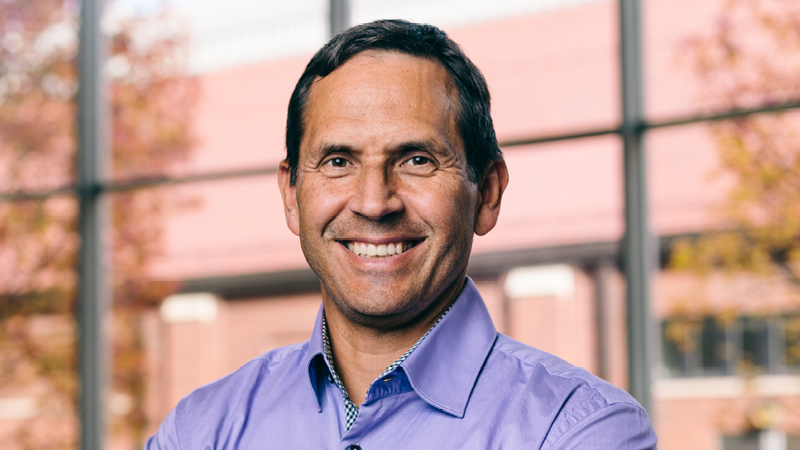Daniel G. Aliaga

Dr. Aliaga performs research in the area of urban visual computing, bringing in his knowledge of computer graphics, computer vision, and AI. He is pioneer of inverse procedural modeling for urban spaces, with his first paper introducing the topic in 2005/2007. His vision is to facilitate semi-automatic and controllable content creation and edition of large and complex geometric models for use in digital simulation, visualization, entertainment, education, … ↓More
Joined department: Fall 2003
Research Areas
- Graphics, Visualization, and Geometric Modeling
- Robotics and Computer Vision
- Artificial Intelligence, Machine Learning, and Natural Language Processing
Education
BS, Honors, Magna Cum Laude,, Brown University, Computer Science (1991)
MS, University of North Carolina at Chapel Hill, Computer Science (1993)
PhD, University of North Carolina at Chapel Hill, Computer Science (1999)
Dr. Aliaga performs research in the area of urban visual computing, bringing in his knowledge of computer graphics, computer vision, and AI. He is pioneer of inverse procedural modeling for urban spaces, with his first paper introducing the topic in 2005/2007. His vision is to facilitate semi-automatic and controllable content creation and edition of large and complex geometric models for use in digital simulation, visualization, entertainment, education, and cultural heritage by converting unstructured data into organized and easily editable representations. To this end, his group has innovated many automatic methods to infer modeling rules and parameter values from 3D models, sketches, images, point clouds, roads, facades, buildings, cities, and vegetation.
In his multi-disciplinary projects, Dr. Aliaga has collaborated with numerous experts in urban planning, atmospheric/geological sciences, civil engineering, architecture, hydrology, and transportation engineering to capture, simulate, and modify models of urban environments. Dr. Aliaga pursues computing and artificial intelligence (AI) tools for improving the complex urban ecosystem and for "what-if" exploration of sustainable urban designs, including integrating urban 3D modeling, simulation, meteorology, vegetation, and traffic modeling.
Further, Dr. Aliaga has developed multiple novel image processing and image-based 3D reconstruction methods. In particular, Dr. Aliaga created the photogeometric structured light method to perform high-accuracy self-calibrating 3D reconstruction. This work led to 3D spatial augmented reality techniques used to perform visual virtual restoration, showcased in several museum applications. In addition, Dr. Aliaga created a novel method to embed a genuinity signature into the surface of 3D objects to detect counterfeiting and tampering. Further, Dr. Aliaga developed custom displays and image rendering methods to compensate for human visual aberrations.
To date, he has developed many algorithms, deployed cyberinfrastructure prototypes and created procedural and generative modeling techniques to create/modify 3D and 2D urban models, published over 160 peer-reviewed papers, member of more than 90 program committees, given numerous international talks (i.e., about 50 talks and presentations in United States, Brasil, Colombia, Ecuador, France, Japan, Korea, Peru, Qatar, Sweden, and Switzerland; including a TEDx talk), driven-forward global efforts (e.g., WUDAPT), received funding support from multiple entities (e.g., NSF, IARPA, USDA, MTC, Google, Microsoft, Adobe) and performed technology transfer (e.g., roles in several startups and multiple patents). Dr. Aliaga performs his research in close interaction with both PhD candidates and with undergraduate students.
Selected Publications
P. Patel, R. Kalyanam, L. He, D. Aliaga, D. Niyogi. Deep Learning based Urban Morphology for City-scale Environmental Modeling, Proceedings of the National Academy of Sciences (PNAS) Nexus, 2023.
L. He, D. Aliaga. GlobalMapper: Arbitrary-Shaped Urban Layout Generation, In Proceedings of IEEE International Conference on Computer Vision (ICCV), 9 pages, 2023.
A. Firoze, C. Wingren, R. Yeh, B. Benes, D. Aliaga, Tree Instance Segmentation with Temporal Contour Graph, In Proceedings of IEEE Computer Vision and Pattern Recognition (CVPR), 9 pages, 2023.
Y. Song, Z. Zhang, Z. Lin, S. Cohen, B. Price, J. Zhang, S. Kim, H. Zhang, D. Aliaga. IMPRINT: Generative Object Compositing by Learning Identity-Preserving Representation. In Proceedings of IEEE Computer Vision and Pattern Recognition (CVPR), 9 pages, 2024.
A. Li, J. Zimmer-Dauphinee, R. Kalyanam, I. Lindsay, P VanValkenburgh, S. Wernker, D. Aliaga, Self-Supervised Large Scale Point Cloud Completion for Archaeological Site Restoration, IEEE Computer Vision and Pattern Recognition (CVPR), 2025.